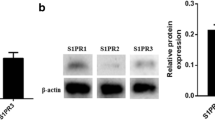Abstract
Vascular inflammation is an important hallmark of high-fat-induced atherosclerosis. Oxidized low-density lipoprotein (ox-LDL) is a key initiator of inflammation as it induces inflammatory gene expression in vascular endothelial cells. Sodium ferulate (SF), an active component from Chinese medicine, demonstrated anti-atherosclerotic potency. However, the mechanism is unknown. Here we investigated how SF changed the cellular gene expression profile and restored ox-LDL-triggered inflammation in HUVECs. Gene expression profile, inflammatory gene expression and NF-κB activation were investigated in human umbilical vein endothelial cells (HUVECs) with or without SF (5 μM) treatment after precondition with ox-LDL (50 μg/mL). Ox-LDL treatment increased the production of IL-1β, CCL20, IL-6, IL-8 and CXCL1. SF stimulation modulated the translocation of NF-κB between cytoplasm and nucleus, and alleviated the inflammatory response induced by ox-LDL. Collectively, SF could suppress the expression of inflammatory factors in ox-LDL-stimulated endothelial cells, and transcription factor NF-κB might be involved in such process.
Similar content being viewed by others
References
Ermak, N., Lacour, B., Drueke, T. B. & Vicca, S. Role of reactive oxygen species and Bax in oxidized low density lipoprotein-induced apoptosis of human monocytes. Atherosclerosis 200:247–256 (2008).
Ross, R. The pathogenesis of atherosclerosis: a perspective for the 1990s. Nature 362:801–809 (1993).
Luscinskas, F. W. & Gimbrone, M. A. Endothelialdependent mechanisms in chronic inflammatory leukocyte recruitment. Annu Rev Med 47:413–421 (1996).
Mantovani, A., Bussolino, F. & Introna, M. Cytokine regulation of endothelial cell function: from molecular level to the bedside. Immunol Today 18:231–240 (1997).
Pahl, H. L. Activators and target genes of Rel/NF-kappaB transcription factors. Oncogene 18:6853–6866 (1999).
Thurberg, B. L. & Collins, T. The nuclear factor-kappa B/inhibitor of kappa B autoregulatory system and atherosclerosis. Curr Opin Lipidol 9:387–396 (1998).
Barnes, P. J. & Karin, M. Nuclear factor-kappaB: a pivotal transcription factor in chronic inflammatory diseases. N Engl J Med 336:1066–1071 (1997).
Makarov, S. S. NF-kappaB as a therapeutic target in chronic inflammation: recent advances. Mol Med Today 6:441–448 (2000).
Tak, P. P. & Firestein, G. S. NF-kappaB: a key role in inflammatory diseases. J Clin Invest 107:7–11 (2001).
Ju, H. S. et al. Scavenging effects of sodium ferulate and 18 beta-glycyrrhetic acid on oxygen free radicals. Zhongguo Yao Li Xue Bao 11:466–470 (1990).
Mathew, S. & Abraham, T. E. Ferulic acid: an antioxidant found naturally in plant cell walls and feruloyl esterases involved in its release and their applications. Crit Rev Biotechnol 24:59–83 (2004).
Ogiwara, T. et al. Radical scavenging activity and cytotoxicity of ferulic acid. Anticancer Res 22:2711–2717 (2002).
Wang, B. H. & Ou-Yang, J. P. Pharmacological actions of sodium ferulate in cardiovascular system. Cardiovasc Drug Rev 23:161–172 (2005).
Wang, B. et al. Sodium ferulate inhibits atherosclerogenesis in hyperlipidemia rabbits. J Cardiovasc Pharmacol 43:549–554 (2004).
Cominacini, L. et al. Oxidized low density lipoprotein (ox-LDL) binding to ox-LDL receptor-1 in endothelial cells induces the activation of NF-kappaB through an increased production of intracellular reactive oxygen species. J Biol Chem 275:12633–12638 (2000).
Xiaohong, Y., Jing-Ping, O. Y. & Shuzheng, T. Angelica protects the human vascular endothelial cell from the effects of oxidized low-density lipoprotein in vitro. Clin Hemorheol Microcirc 22:317–323 (2000).
Havel, R. J., Eder, H. A. & Bragdon, J. H. The distribution and chemical composition of ultracentrifugally separated lipoproteins in human serum. J Clin Invest 34:1345–1353 (1955).
Cominacini, L. et al. A simple test for predisposition to LDL oxidation based on the fluorescence development during copper-catalyzed oxidative modification. J Lipid Res 32:349–358 (1991).
Littlewood, T. D. & Bennett, M. R. Apoptotic cell death in atherosclerosis. Curr Opin Lipidol 14:469–475 (2003).
Zhang, R., Ma, J., Xia, M., Zhu, H. & Ling, W. Mild hyperhomocysteinemia induced by feeding rats diets rich in methionine or deficient in folate promotes early atherosclerotic inflammatory processes. J Nutr 134:825–830 (2004).
Galle, J., Hansen-Hagge, T., Wanner, C. & Seibold, S. Impact of oxidized low density lipoprotein on vascular cells. Atherosclerosis 185:219–226 (2006).
Sun, J. et al. Mast cells promote atherosclerosis by releasing proinflammatory cytokines. Nat Med 13:719–724 (2007).
Tedgui, A. & Mallat, Z. Cytokines in atherosclerosis: pathogenic and regulatory pathways. Physiol Rev 86:515–581 (2006).
Murphy, P. M. et al. International union of pharmacology. XXII. Nomenclature for chemokine receptors. Pharmacol Rev 52:145–176 (2000).
Zlotnik, A. & Yoshie, O. Chemokines: a new classification system and their role in immunity. Immunity 12:121–127 (2000).
Kuziel, W. A. et al. Severe reduction in leukocyte adhesion and monocyte extravasation in mice deficient in CC chemokine receptor 2. Proc Natl Acad Sci USA 94:12053–12058 (1997).
Baeuerle, P. A. & Baltimore, D. NF-kappa B: ten years after. Cell 87:13–20 (1996).
Dandona, P., Chaudhuri, A., Ghanim, H. & Mohanty, P. Proinflammatory effects of glucose and anti-inflammatory effect of insulin: relevance to cardiovascular disease. Am J Cardiol 99:15B–26B (2007).
Harokopakis, E., Albzreh, M. H., Haase, E. M., Scannapieco, F. A. & Hajishengallis, G. Inhibition of proinflammatory activities of major periodontal pathogens by aqueous extracts from elder flower (Sambucus nigra). J Periodontol 77:271–279 (2006).
Kwon, K. B. et al. Sophorae radix extract inhibits high glucose-induced vascular cell adhesion molecule-1 upregulation on endothelial cell line. Clin Chim Acta 348:79–86 (2004).
Lee, Y. J., Kang, D. G., Kim, J. S. & Lee, H. S. Lycopus lucidus inhibits high glucose-induced vascular inflammation in human umbilical vein endothelial cells. Vascul Pharmacol 48:38–46 (2008).
Author information
Authors and Affiliations
Corresponding author
Rights and permissions
About this article
Cite this article
Tao, J., Zhang, D., Man, Y. et al. Sodium ferulate inhibits high-fat diet-induced inflammatory factors expression in human umbilical vein endothelial cells. Mol. Cell. Toxicol. 12, 117–123 (2016). https://doi.org/10.1007/s13273-016-0015-0
Received:
Accepted:
Published:
Issue Date:
DOI: https://doi.org/10.1007/s13273-016-0015-0




